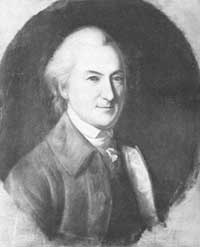







Biographical Sketches
|
JOHN DICKINSON Delaware |
 John Dickinson | |
| ||
Dickinson, "Penman of the Revolution," was born in 1732 at Crosiadore estate, near the village of Trappe in Talbot County, Md. He was the second son of prosperous farmer Samuel and Mary (Cadwalader) Dickinson, his second wife. In 1740 the family moved to Kent County near Dover, Del., where private tutors educated the youth. In 1750 he began to study law with John Moland in Philadelphia. In 1753 Dickinson went to England to continue his studies at London's Middle Temple. Four years later, he headed back to Philadelphia and became a prominent lawyer there. In 1770 he married Mary Norris, daughter of a wealthy merchant. The couple was to have at least one daughter.
By that time, Dickinson's superior education and talents had propelled him into politics. In 1760 he had served in the assembly of the Three Lower Counties (Delaware), where he held the speakership. Combining his Pennsylvania and Delaware careers in 1762, he won a seat as a Philadelphia member in the Pennsylvania assembly and sat there again in 1764. He became the leader of the conservative side in the colony's political battles. His defense of the Proprietary Governor against the faction led by Benjamin Franklin hurt his popularity, but earned him respect for his integrity. Nevertheless, as an immediate consequence, he lost his legislative seat in 1764.
Meantime, the struggle between the Colonies and the mother country had waxed strong and Dickinson had emerged in the forefront of Revolutionary thinkers. In the debates over the Stamp Act (1765), he played a key part. That year, he authored The Late Regulations Respecting the British Colonies . . . Considered, an influential pamphlet that urged Americans to seek repeal of the act by pressuring British merchants. Accordingly, the Pennsylvania legislature appointed him as a delegate to the Stamp Act Congress, whose resolutions he drafted.
In 1767-68 Dickinson wrote a series of newspaper articles in the Pennsylvania Chronicle that came to be known collectively as Letters from a Farmer in Pennsylvania .... They attacked British policy and, though recognizing the feasibility of reconciliation, suggested that force might be the ultimate solution. So popular were the Letters in the Colonies that Dickinson received an honorary LL.D. from the College of New Jersey (later Princeton) and public thanks from a meeting in Boston. In 1768, responding to the Townshend Duties, he championed rigorous colonial resistance in the form of nonimportation and nonexportation agreements.
In 1771, back in the Pennsylvania legislature, Dickinson drafted a petition to the King that was unanimously approved. Because of his continued opposition to the use of force, however, by 1774 he had lost much of his popularity. Particularly resenting the tactics of New England leaders, that year he refused to support aid requested by Boston in the wake of the Intolerable Acts, though he sympathized with the city's plight. Reluctantly, Dickinson was drawn into the Revolutionary fray. In 1774 he chaired the Philadelphia committee of correspondence and briefly sat in the First Continental Congress, representing Pennsylvania.
Throughout 1775, though supporting the Whig cause, Dickinson continued to work for peace. He drew up petitions asking the King for redress of grievances. At the same time, he chaired a Philadelphia committee of safety and defense and held a colonelcy in the first battalion recruited in Philadelphia to defend the city.
After Lexington and Concord, Dickinson continued to hope for a peaceful solution. In the Second Continental Congress (1775-76), still a representative of Pennsylvania, he drew up the Declaration of the Causes of Taking Up Arms. In the Pennsylvania assembly, he drafted an authorization to send Delegates to Congress in 1776. It directed them to seek redress of grievances, but ordered them to oppose separation of the Colonies from Britain.
By that time, Dickinson's moderate position had left him in the minority. In Congress he voted against the Declaration of Independence (1776) and refused to sign it. Nevertheless, he then became one of only two congressional Members (with Thomas McKean) at the time who entered the military, but when he was not reelected he resigned his brigadier general's commission and withdrew to his estate in Delaware. Later in 1776, though reelected to Congress by his new constituency, he declined to serve, and also resigned from the Pennsylvania assembly. He may have taken part in the Battle of Brandywine, Pa. (September 11, 1777), as a private but otherwise saw no further military action.
Dickinson came out of retirement to take a seat in the Continental Congress (1779-80), where he signed the Articles of Confederation; earlier he had headed the committee that had drafted them. In 1781 he became president of Delaware's Supreme Executive Council. Shortly thereafter, he moved back to Philadelphia. There, he became president of Pennsylvania (1782-85). In 1786, representing Delaware, he attended and chaired the Annapolis Convention.
The next year, Delaware sent Dickinson to the Constitutional Convention. He missed a number of sessions and left early because of illness, but he made worthwhile contributions, including service on the committee on postponed matters. Although he resented the forcefulness of Madison and the other nationalists, he helped engineer the Great Compromise and wrote public letters supporting constitutional ratification. Because of his premature exit from the Convention, he did not actually sign the Constitution, but authorized his friend and fellow-delegate George Read to do so for him.
Dickinson lived for two decades more, but held no public offices. Instead, he devoted himself to writing on politics, and in 1801 published two volumes of his collected works. He died at Wilmington in 1808 at the age of 75 and was entombed in the Friends Burial Ground.
Drawing: Oil (1782) by Charles Willson Peale. Independence National Historical Park.
 |
 |
http://www.cr.nps.gov/history/online_books/constitution/bio12.htm
Last Updated: 29-Jul-2004